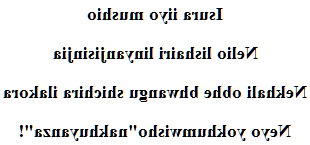Oluluyia love poem
Shio
Isura iiyo mushio
Nelio lishairi linyanjisinjia
Nekhali obhe bhwangu shichira ilakora
Neyo yokhumwisho "nakhuyanza"!


→ French poem ←
Mtsotso dialect
Luyia love poem (variants : Oluluyia, Luhia, Luhiya, Luhya, Mtsotso, Songa, Menya, Dadiri, Marachi, Wesi, Buya, Sabi, Marama, Gisu, Gwe, Idakho, Songa, Hadyo, Logoori, Tachoni, Nyala-Est, Wanga, Isukha, Nyore, Masaba, Kisa, Saamia, Nyala-West, Kabaras, Khayo, Tsotso, Nyole, Tiriki, Tura, Syan).
The translation of my little poem is exactly in Mtsotso (Tsotso) dialect, the Bantu language of the Luhyas. They are found mainly in western Kenya, Tanzania and Uganda.
The Luyia (Abaluyia, Tsotso, Abatsotso, Bukusu, Luhya, Isukha, Saamia, Tirik, Nyore, Tachoni, Nyala, Maragoli, Idakho) who are 8 million, are distributed mainly between Uganda and Kenya, represent the second largest group in number in Kenya, the Kikuyu being the most numerous.
Luyia more than a language, is a macrolanguage, that is to say a set of languages very close to each other. There would be about twenty dialects or variants of Luyia, which are more or less understandable between them.
The name Luhya would mean "who are of the same house"! Some consider wanga to be the standard for luyia.
The Luhyas
The Luhyas are about 5 million, and are the second largest group in Kenya. They are most often farmers and breeders.
The customs, culture and traditions of the different Luyia groups remain alive. Magic, witchcraft, animism, circumcision, rites around death are part of their life.
The Bantu unity is demonstrated around 1860 by W.Bleek, who is the creator of the Bantu term (people), consisting of the lexical root "ntu" and the prefix attached to the class of human names in the plural "ba".
This system of nominal classes is indeed the first criterion which characterizes the Bantu languages: each name or pronoun is preceded by a prefix which characterizes its class; This prefix must be repeated before all the words which depend on the substantive. The number of Bantu languages varies according to the author, between 300 and 600.